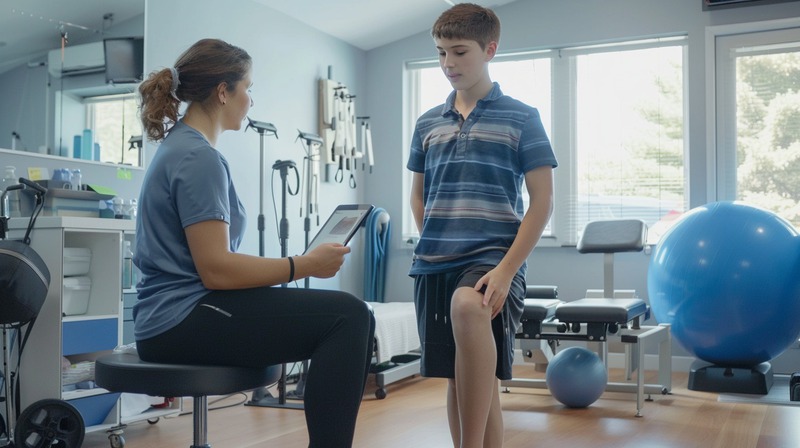
Physical therapy is crucial to managing chronic pain, as it offers a holistic and proactive approach to treating the underlying causes of pain. Chronic pain can be debilitating, affecting a person’s ability to perform daily activities and leading to a decreased quality of life. Physical therapy is designed to help individuals understand and manage their pain while improving their physical function, mobility, and overall well-being.
By utilizing a variety of techniques such as exercise, manual therapy, and education, physical therapists work to address the root causes of chronic pain and promote long-term relief. Here are several detailed ways in which physical therapy helps alleviate chronic pain:
1. Customized Exercise Programs
Physical therapists design personalized exercise programs tailored to patients’ conditions and pain levels. These exercises strengthen muscles, improve flexibility, and enhance overall physical function. Strengthening weak muscles and improving flexibility can help reduce strain on painful areas, ultimately alleviating chronic pain. Additionally, professionals specializing in occupational therapy South Carolina offer a variety of therapeutic interventions that complement physical therapy, aiding in the holistic improvement of patients’ well-being.
2. Improving Mobility and Function
Chronic pain often leads to reduced mobility and impaired function. Physical therapists work with patients to restore and improve their range of motion and physical capabilities through targeted exercises and movement strategies. Improved mobility can reduce stiffness and prevent the worsening of pain over time.
3. Pain Relief Techniques
Physical therapy incorporates various techniques specifically aimed at pain relief, such as:
-
Manual Therapy: Hands-on massage, joint mobilization, and myofascial release help reduce pain and improve tissue function.
-
Heat and Cold Therapy: Heat can relax muscles and improve blood flow, while cold therapy can reduce inflammation and numb painful areas.
-
Electrical Stimulation: Techniques like TENS (Transcutaneous Electrical Nerve Stimulation) use electrical impulses to disrupt pain signals to the brain, providing relief.
-
Ultrasound Therapy: Sound waves penetrate deep tissues to reduce inflammation and promote healing.
4. Education and Self-Management Strategies
Physical therapists educate patients about their condition and pain management strategies. This education includes:
-
Posture and Ergonomics: Teaching proper posture and ergonomic techniques to reduce stress on the body and prevent pain exacerbation.
-
Body Mechanics: Instructing on correct body movements to avoid further injury and pain.
-
Pain Management Techniques: Providing strategies for coping with pain, such as relaxation techniques, pacing activities, and energy conservation.
5. Enhancing Body Awareness
Physical therapy Belton helps increase body awareness through proprioceptive and kinesthetic exercises. By improving their ability to sense body position and movement, patients can identify and modify harmful movement patterns, reducing pain and improving overall function.
6. Reducing Dependence on Medications
Chronic pain often leads to long-term use of pain medications, which can have side effects and the potential for dependency. Physical therapy offers a non-pharmacological approach to pain management, which can help reduce the need for medications. By addressing the root causes of pain and improving physical function, patients may find relief without relying heavily on drugs.
7. Improving Mental Health
Chronic pain is often associated with mental health issues such as anxiety, depression, and stress. Physical therapy, like elite movement management, addresses the physical aspects of pain and contributes to improved mental well-being. Regular physical activity and exercise release endorphins, which are natural mood elevators. Additionally, the support and encouragement from a physical therapist can boost a patient’s confidence and outlook, leading to a more positive mental state.
8. Preventing Recurrence and Managing Flare-Ups
Physical therapists teach patients how to prevent pain recurrence and manage flare-ups. This involves:
-
Home Exercise Programs: Providing exercises that patients can perform at home to maintain strength and flexibility.
-
Activity Modification: Advising how to modify activities to reduce pain and avoid triggers.
-
Early Intervention Strategies: Teaching patients to recognize early signs of a flare-up and take appropriate action to prevent it from worsening.
9. Holistic Approach
Physical therapy takes a holistic approach to managing chronic pain by considering the whole person, not just the painful area. This approach includes evaluating and addressing factors such as lifestyle, diet, sleep, and stress levels, all of which can influence pain. Physical therapy can lead to more sustainable pain relief by improving overall health and wellness.
10. Long-Term Benefits
The benefits of physical therapy extend beyond immediate pain relief. By improving strength, mobility, and function, patients are better equipped to handle daily activities and enjoy a higher quality of life. This long-term improvement helps prevent the development of secondary issues related to chronic pain, such as decreased physical activity, weight gain, and additional health problems
Final Thoughts
Physical therapy plays a vital role in helping individuals manage chronic pain by addressing its underlying causes and promoting long-term relief. Through exercise, manual therapy, and education, physical therapists work to improve mobility, reduce pain, and enhance overall quality of life. By empowering individuals to take an active role in managing their pain, physical therapy offers a holistic approach to pain management that can lead to significant improvements in function and well-being.






